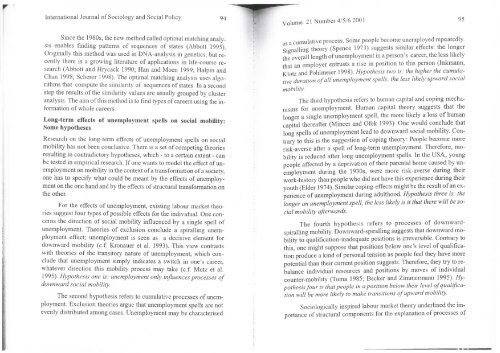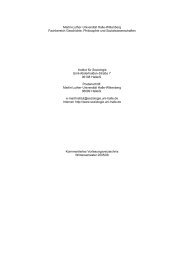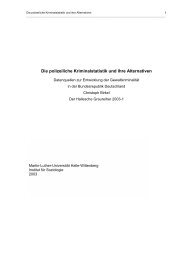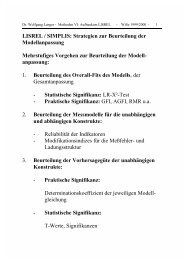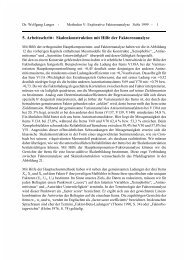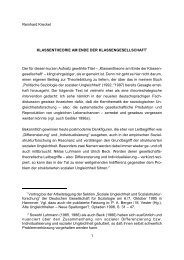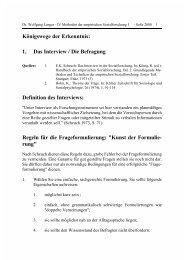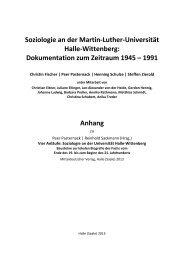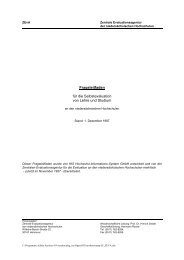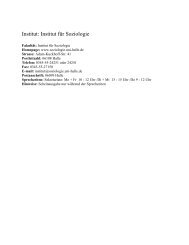EXPLAINING SOCIAL EXCLUSION - Institut für Soziologie
EXPLAINING SOCIAL EXCLUSION - Institut für Soziologie
EXPLAINING SOCIAL EXCLUSION - Institut für Soziologie
Create successful ePaper yourself
Turn your PDF publications into a flip-book with our unique Google optimized e-Paper software.
International Journal of Sociology and Social Policy 94<br />
Since the 1980s, the new method called optimal matching analysis<br />
enables fmding patterns of sequences of states (Abbott 1995).<br />
Originally this method was used in DNA-analysis in genetics, but recently<br />
there is a growing literature of applications in life-course research<br />
(Abbott and Hrycack 1990; Han and Moen 1999; Halpin and<br />
Chan 1998; Scherer 1998). The optimal matching analysis uses algorithms<br />
that compute the similarity of sequences of states. In a second<br />
step the results of the similarity values are usually grouped by cluster<br />
analysis. The aim of this method is to find types of careers using the information<br />
of whole careers.<br />
Long-term effects of Unemployment spells on social mobility:<br />
Some hypotheses<br />
Research on the long-term effects of Unemployment spells on social<br />
mobility has not been conclusive. There is a set of competing theories<br />
resulting in contradictory hypotheses, which - to a certain extent - can<br />
be tested in empirical research. If one wants to model the effect of unemployment<br />
on mobility in the context of a transformation of a society,<br />
one has to specify what could be meant by the effects of unemployment<br />
on the one band and by the effects of structural transformation on<br />
the other.<br />
For the effects of Unemployment, existing labour market theories<br />
suggest four types of possible effects for the individual. One concerns<br />
the direction of social mobility influenced by a single spell of<br />
Unemployment. Theories of exclusion conclude a spiralling unemployment<br />
effect; unemployment is seen äs a decisive element for<br />
downward mobility (c.f. Kronauer et al. 1993). This view contrasts<br />
with theories of the transitory nature of unemployment, which conclude<br />
that unemployment simply indicates a switch in one's career,<br />
whatever direction this mobility process may take (c.f. Mutz et al.<br />
1995). Hypothesis one is: unemployment only influencesprocesses of<br />
downward social mobility.<br />
The second hypothesis refers to cumulative processes of unemployment.<br />
Exclusion theories argue that unemployment spells are not<br />
evenly distributed among cases. Unemployment may be characterised<br />
Volume 21 Number 4/5/6 2001 95<br />
äs a cumulative process. Some people become unemployed repeatedly.<br />
Signalling theory (Spence 1973) suggests similar effects: the longer<br />
the overall length of unemployment in a person's career, the less likely<br />
that an employer entrusts a rise in position to this person (Inkmann,<br />
Klotz and Pohlmeier 1998). Hypothesis two is: the higher the cumulative<br />
duration of all unemployment spells, the less likely upward social<br />
mobility.<br />
The third hypothesis refers to human capital and coping mechanisms<br />
for unemployment. Human capital theory suggests that the<br />
longer a single unemployment spell, the more likely a loss of human<br />
capital thereafter (Mincer and Ofek 1993). One would conclude that<br />
long spells of unemployment lead to downward social mobility. Contrary<br />
to this is the Suggestion of coping theory: People become more<br />
risk-averse after a spell of long-term unemployment. Therefore, mobility<br />
is reduced after long unemployment spells. In the USA, young<br />
people affected by a deprivation of their parental home caused by unemployment<br />
during the 1930s, were more risk-averse during their<br />
work-history than people who did not have this experience during their<br />
youth (Eider 1974). Similar coping-effects might be the resultof an experience<br />
of unemployment during adulthood. Hypothesis three is: the<br />
longer an unemployment spell, the less likely is it that there will be social<br />
mobility afterwards.<br />
The fourth hypothesis refers to processes of downwardspiralling<br />
mobility. Downward-spiralling suggests that downward mobility<br />
to qualification-inadequate positions is irreversible. Contrary to<br />
this, one might suppose that positions below one's level of qualification<br />
produce a kind of personal tension äs people feel they have more<br />
Potential than their current position suggests. Therefore, they try to rebalance<br />
individual resources and positions by moves of individual<br />
counter-mobility (Tuma 1985; Becker and Zimmermann 1995). Hypothesis<br />
four is that people in a position below their level ofqualification<br />
will be more likely to make transitions of upward mobility.<br />
Sociologically inspired labour market theory underlined the importance<br />
of structural components for the explanation of processes of


